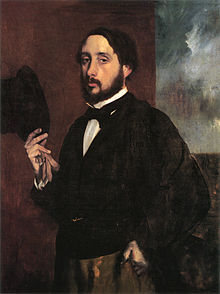
Back Edgar Degas Afrikaans Edgar Degas ALS Edgar Degas AN إدغار ديغا Arabic ادجار ديجا ARZ Edgar Degas AST Edgar Degas Aymara Edqar Deqa Azerbaijani Эдгар Дега Bashkir Эдгар Дэга Byelorussian
Edgar Degas | |
|---|---|
 Self-portrait (Degas Saluant), 1863 | |
| Born | Hilaire-Germain-Edgar De Gas 19 July 1834 Paris, Kingdom of France |
| Died | 27 September 1917 (aged 83) Paris, France |
| Known for | Painting, sculpture, drawing |
| Notable work |
|
| Movement | Impressionism |
| Signature | |
 | |
Edgar Degas (UK: /ˈdeɪɡɑː/, US: /deɪˈɡɑː, dəˈɡɑː/;[1][2] born Hilaire-Germain-Edgar De Gas, French: [ilɛːʁ ʒɛʁmɛ̃ ɛdɡaʁ də ɡa]; 19 July 1834 – 27 September 1917) was a French Impressionist artist famous for his pastel drawings and oil paintings.
Degas also produced bronze sculptures, prints, and drawings. Degas is especially identified with the subject of dance; more than half of his works depict dancers.[3] Although Degas is regarded as one of the founders of Impressionism, he rejected the term, preferring to be called a realist,[4] and did not paint outdoors as many Impressionists did.
Degas was a superb draftsman, and particularly masterly in depicting movement, as can be seen in his rendition of dancers and bathing female nudes. In addition to ballet dancers and bathing women, Degas painted racehorses and racing jockeys, as well as portraits. His portraits are notable for their psychological complexity and their portrayal of human isolation.[5]
At the beginning of his career, Degas wanted to be a history painter, a calling for which he was well prepared by his rigorous academic training and close study of classical Western art. In his early thirties he changed course, and by bringing the traditional methods of a history painter to bear on contemporary subject matter, he became a classical painter of modern life.[6]
- ^ Upton, Clive; Kretzschmar, William A. Jr. (2017). The Routledge Dictionary of Pronunciation for Current English (2nd ed.). Routledge. p. 330. ISBN 978-1-138-12566-7.; Bollard, John K. (1998). Pronouncing Dictionary of Proper Names (2nd ed.). Detroit, MI: Omnigraphics, Inc. p. 272. ISBN 978-0-7808-0098-4.
- ^ Wells, John C. (2008). Longman Pronunciation Dictionary (3rd ed.). Longman. ISBN 978-1-4058-8118-0.
- ^ Trachtman, Paul, Degas and His Dancers, Smithsonian Magazine, April 2003
- ^ Gordon and Forge 1988, p. 31
- ^ Brown 1994, p. 11
- ^ Turner 2000, p. 139